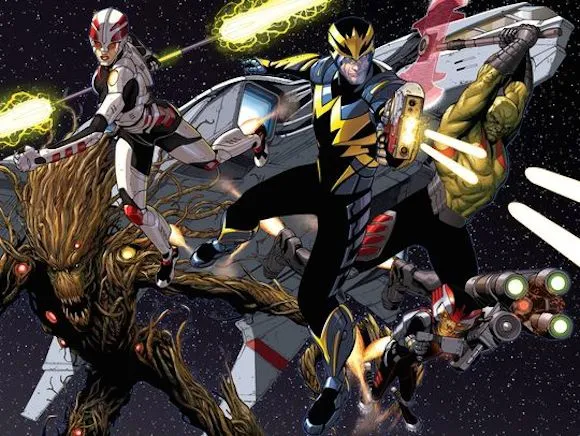This summer, Marvel Studios is bringing Guardians of the Galaxy to the silver screen. The original team known by that name were freedom fighters from different human colonies who operated in the 30th century. In more recent years, the name was revived for a modern-day team of misfit heroes who banded together under the leadership of Peter Jason Quill AKA the Star-Lord. The modern-day version of the team is the one that will appear on-screen and Star-Lord will be played by Chris Pratt, famous for his roles in Parks and Recreation and films such as Her and Zero Dark Thirty.
But who is this guy? Not Pratt, we know that he’s a hilarious and affable actor. I mean Peter Quill. What’s his deal? How have his role, origin and sense of style changed over the years? What was the original intention? What with those funky helmets he wears? It’s all right here for you to enjoy!
ASTROLOGICAL HERO
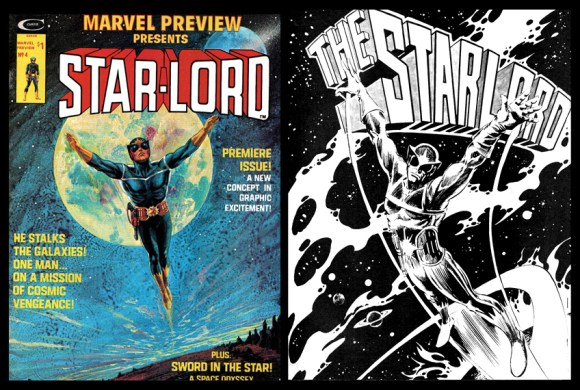
In the mid-1970s, Marvel Comics produced a black and white magazine-sized anthology series called Marvel Preview. This anthology featured stories intended for a slightly more mature audience and that didn’t necessarily take place in the Marvel Universe. The editor for the book was Marv Wolfman, who would later gain acclaim for his work on such titles as The New Teen Titans and Crisis on Infinite Earths. Wolfman wanted to introduce an original character in the pages of Marvel Preview and asked writer Steven Englehart to come up with something. He told Englehart that he wanted a science fiction adventurer rather than an Earthbound superhero, suggesting the name “Star-Lord.”
By the way, a quick note about the name spelling consistency. The covers for most of the character’s stories over the years have used a hyphen in the name. But until several years ago, the interior pages of those same stories usually didn’t use the hyphen. Since the mini-series Annihilation: Conquest – Starlord in 2007, the name has been spelled consistently with a hyphen in interior pages, which is ironic since that mini-series title didn’t use it. For simplicity’s sake, I’m just consistently spelling Star-Lord with a hyphen except when I reference a specific series title that didn’t use it. Back to the show.
Englehart decided that the protagonist, whom he named Peter Jason Quill, would start off as the kind of jerk who would never be a superhero in the Marvel Universe, at least not until after he’d done some serious growing up. At the time, Englehart had become very interested in astrology and so he chose February 4th, 1962 as Quill’s birth date. This was the same day a planetary alignment had occurred (not just in the story, but in reality) and was the date that Samuel Aun Weor, founder of the Universal Christian Gnostic Movement, declared as the beginning of the Age of Aquarius. Englehart wanted Peter Quill to be an Aquarius because he thought it symbolized that he stood outside of the flow of the universe and gained a unique perspective.
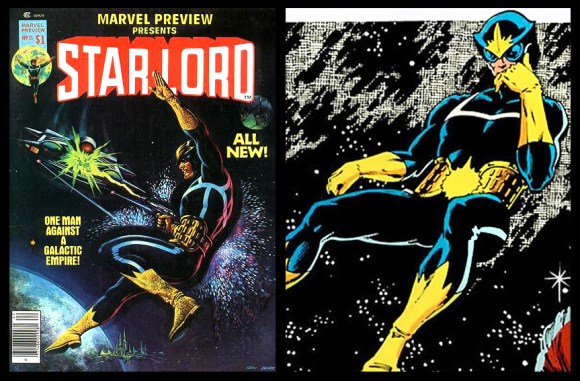
In any case, Peter Quill was born at home in the American Mid-West. Seeing no resemblance of himself in Peter, his father believed this was someone else’s child and attempted to kill the newborn, only to then suffer a sudden and fatal heart attack. Eleven years later, Peter and his mother Meredith came across a scouting party of reptilian aliens. The aliens killed her and then fled, leaving Peter an orphan with a story of invaders that no one believed. Fast forward to the year 1989 (fifteen years in the future for readers of this story). Peter Quill was now an astronaut, having chosen the life due to his experience with alien invaders and his love of science fiction, such as Star Trek, Flash Gordon and the works of E.E. “Doc” Smith. He is noted for being brave and willing to risk his life for others without hesitation, but is also socially inept and has a grandiose sense of entitlement. As an adult, Quill still has no friends beyond his pet owl.
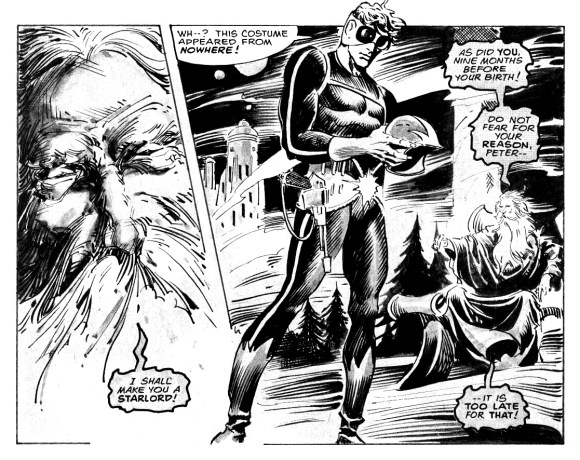
Peter Quill learns to bury his true feelings enough that people find his behavior more acceptable and he gets a posting on a Mars space station. Then, on January 26, 1990, an alien intelligence telepathically contacts the station astronauts and says that they have two weeks to select one of their own to inherit the mantle of the Star-Lord. Determined that it will be him, Peter attacks the others (and possibly kills one guy), only to then find himself transported to an alien city. There, he meets the Master of the Sun, who is either a strange, old wizard or God incarnate (and who later implies that Peter may have been an immaculate conception). Peter suddenly loses his sense of entitlement and admits that he is dangerous and possibly crazy. Seeing his humility and his potential, the Master of the Sun instantly equips Peter with the uniform and weapon traditionally given to the Star-Lord.
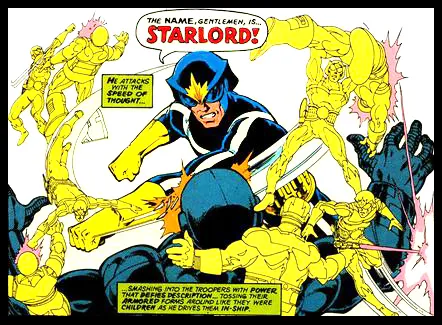
Being the Star-Lord meant you were appointed as a peacekeeper of outer space, a sort of cosmic guardian. With the helmet and belt, the outfit Peter Quill wears certainly looks like some kind of uniform rather than just another superhero costume. It’s a black and white uniform which makes sense for the black and white comic. It also provides the wearer flight and protection from the vacuum of space. The Star-Lord symbol on the helmet (and boots) is interesting in that it doesn’t look like standard star symbol you see worn by Captain Marvel, Ms. Marvel, Northstar and others. The starburst seems to imply flame or a nova rather than just a shining object. The belt buckle looks like a sun but does not exactly match the helmet’s symbol, which is a nice way of preventing redundancy in the design.
The only thing I’m not wild about is the gun. This is supposed to be Star-Lord’s near-invincible weapon, able to unleash and manipulate the power of all four classic elements (earth, air, fire, water) and limited mainly by the user’s willpower. I don’t know, the gun itself just doesn’t look that impressive to me. Maybe because it’s too obvious as a standard weapon. It doesn’t help that Peter, in his debut story, compares the role of a Star-Lord to being a Lensman. If you don’t know, this is a reference to characters from the famous and influential science fiction novels written by E.E. “Doc” Smith. The Lensman series, which ran from 1937 to 1950, is believed by some to be an inspiration for the Green Lantern Corps, and it almost won the Hugo Award for Best All-Time Series, losing it to Isaac Asimov’s Foundation trilogy. Each Lensman was a person deemed worthy enough to wield a Lens, which would then only work for the chosen bearer and endow them with great mental abilities. The Lens (or a Green Lantern ring) sounds more in keeping with the power and role Star-Lord was supposed to have than a ray gun that looks like a prop from Flash Gordon.
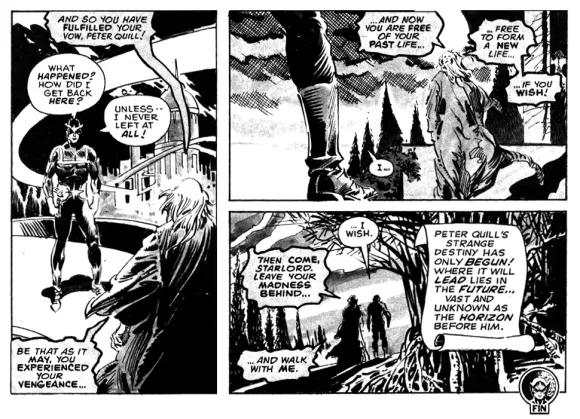
Back to the story. The Master of the Sun knows Peter still craves revenge for his mother’s death, so he instantly teleports the new Star-Lord into the presence of the same unnamed reptilian aliens who killed Meredith. Using his new abilities and equipment, Peter kills them all and puts to rest some of the pain from his past. He then finds himself back in the Master of the Sun’s presence and suddenly wonder if his revenge really happened or was an illusion. Either way, he now has some peace that he didn’t have before. The Master of the Sun tells him, “Leave your madness behind . . . and walk with me.”
Thus ended what was meant to be the first of a twelve-part series, based on the twelve astrological houses, where Peter would slowly evolve into a cosmic philosopher and peacekeeper. This first chapter was “Earth.” As Englehart explained later on his own website: “After [Peter Quill’s] earthbound beginning, his mind would be opened step by step, with a fast-action story on Mercury, a love story on Venus, a war story on Mars, and so on out to the edge of the solar system, and then beyond.”
But we never got to see that journey. Steve Englehart was picked up by DC Comics then and went on to do some great work, including a run of Batman stories that were highly influential on the 1990s Batman: The Animated Series. Star-Lord wasn’t seen again until Marvel Preview #9, when he had a new creative team and a new direction.
PLANS CHANGE
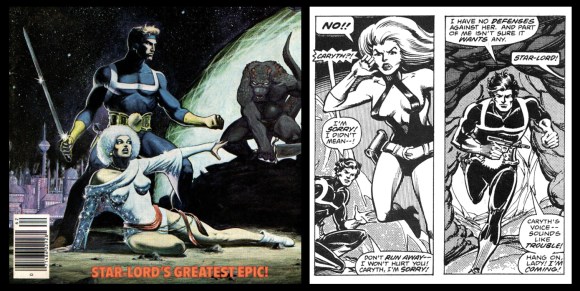
With Engleheart gone, Marvel turned the Star-Lord character over to Chris Claremont, who’d recently begun his historic run on Uncanny X-Men. Claremont didn’t want to deal with showing Quill’s journey from jerk to hero, so he picked up the story years later, showing a Star-Lord who was now calmer, more noble and more personable. Under Claremont, Star-Lord wasn’t a cosmic guardian who had “inherited the universe,” but a more straightforward adventurer. According to Claremont, he had mastery over language, all things mechanical, and, thanks to his gun, the four primal elements. He went about in a sentient spaceship named Ship, acting as an intergalactic trouble-shooter.
John Byrne did the art, followed by Carmine Infantino in later issues. Byrne and Claremont’s stories were later reprinted in colorized editions. Neither Byrne nor Infantino seemed to be fans of Star-Lord’s helmet, so they often had him ditch it and operate without any kind of mask.
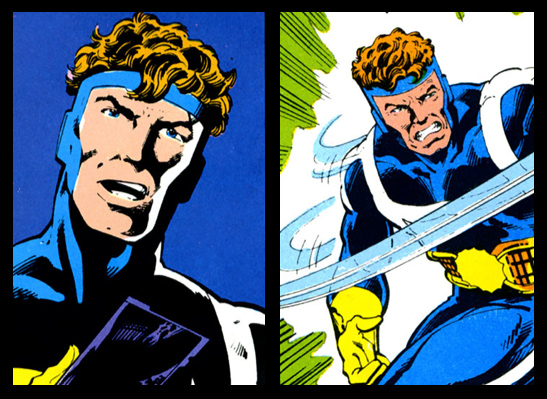
Sometimes, Byrne played with losing Peter’s helmet and goggles and giving him this weird cowl thing that sometimes appears in superhero comics and which I’ve never really understood. It looks a bit like what someone would wear for skiing and it has no practical purpose for Peter Quill. I’d ditch it.
Here’s a little bit of color-based trivia concerning our hero here. The covers of Marvel Preview depicted Peter Quill as blond when he had his helmet off. But when Claremont and Byrne’s stories were reprinted, the colorized interior pages had him as a brunette. So that became the accepted coloring for several years.
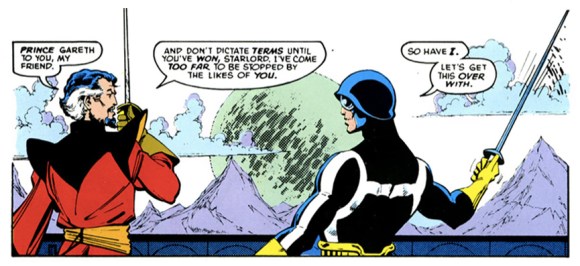
Soon after taking over, Claremont further developed the origin of Star-Lord when he had the hero meet his true father, Emperor Jason of Sparta, homeworld of the Spartax Empire. The Emperor explained that he had spent a year on Earth while he was repairing his ship and during that time had lived with Peter’s mother Meredith. When he’d left, it was to return to a war his people were involved in, so he left Merdith and their unborn son behind. Then, apparently for his own protection, he erased her memory of the past year. Because it’s not at all an awful violation to impregnate a woman and then remove all knowledge she has of your existence and how she got pregnant, along with a whole year of her life. Meredith lived in the woods, she probably didn’t do much worth remembering, right? A month later, she married the guy Peter had thought was his father, an old high school sweetheart, which apparently was why the lady didn’t think she’d had an immaculate conception.
Following the end of the war, Emperor Jason sent his uncle Jareth to retrieve Meredith and Peter. But Jareth had eyes on the throne and so he instead sent an assassination squad. These reptilian enemies killed Meredith but missed Peter and then, bizarrely, just gave up and left. Peter learned of Jareth’s involvement only after he had killed the man during a sword duel, so it turned out he had conveniently already finished avenging his mother without even knowing it.
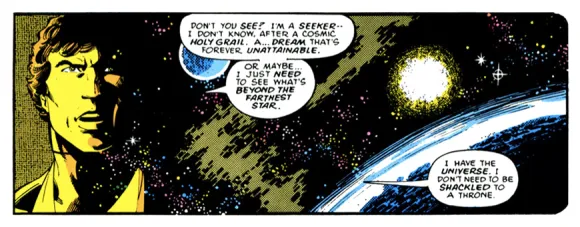
After hearing this story of his origin, Peter Quill decided to continue his journey through space rather than stay and be bound by life in the royal court. This led to the further adventures that were drawn by Carmine Infantino. In those stories, it was revealed that Ship had a female personality and was in love with Peter. She even took on female form at one point and pretended to be a woman named Carynth, aiding Star-Lord on an adventure and sharing a kiss with him. Peter couldn’t explain why he was drawn to this mysterious woman who spent half the story naked due to a monokini outfit that was easily torn apart when she faced danger. Ship later resumed her true form, admitted her deception to Peter, who then laughed the experience off (wait, really??) and the two continued their travels with nary a care in the world.
In 1982, Byrne and Claremont’s stories of Spartax and Jason’s birth origin were colorized and reprinted in Star-Lord Special Edition. An epilogue was then added, written by Claremont and with art by Michael Golden. It revealed that Peter Quill did return to his father many years later, on the eve that Jason was set to abdicate the throne. In the dead of night, Jason joined his son aboard Ship and they flew off into deep space. The implication was that Peter, Jason and Ship would never be heard from again. As of 1982, the story was over.
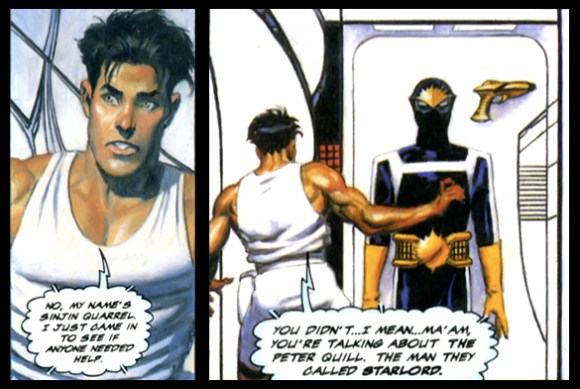
In 1996, a new Starlord mini-series came out, written by science fiction author Timothy Zahn. The mini-series took place over a decade after Peter Quill was last seen and featured a young man named Sinjin Quarrell coming into possession of the Star-Lord equipment. Quarrell never had any subsequent adventures and was never mentioned again.
JOINING THE MARVEL UNIVERSE
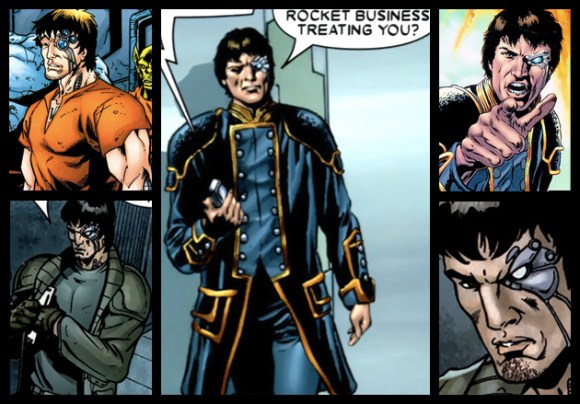
In 2006, Marvel brought back Peter Quill in the pages of Thanos, finally officially integrating him into the Marvel Universe and setting him up to be part of the crossover story Annihilation. Peter Quill was now a harder-edged man, one who wished to forget the past and disliked that some people still saw him as Star-Lord, a walking symbol of hope. Eventually he admitted that he had fought the Fallen One, a former herald of the world-devouring entity Galactus. The confrontation hadn’t gone well. Ship was killed and the element gun was destroyed. Star-Lord only achieved victory by sacrificing an inhabited world. His injuries led to his receiving cybernetic implants and then he turned himself in to the authorities, wishing to be held responsible for the deaths he’d caused. This is why we found him in a prison during Annihilation, which put him in a perfect position to aid other heroes in during that crisis. Following the Annihilation War, Star-Lord became advisor to Ronan the Accuser, a major figure of the alien Kree Empire.
There’s not much to say about the design of Star-Lord as a cyborg. He just wore the basic clothing that fit the situation, with a cool coat when he became advisor to the Kree defense. Somewhat annoyingly, there was no consensus among artists as to what his cybernetic implants looked like, so this varied from issue to issue.
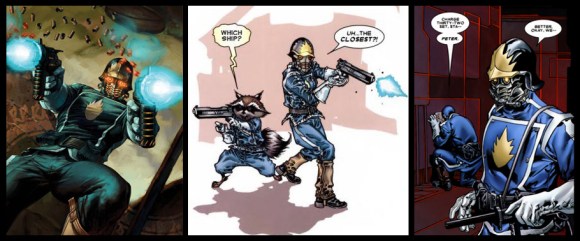
Sadly, Star-Lord’s efforts to coordinate defenses led to a massive defeat by the techno-organic race known as the Phalanx. The Phalanx War was the focus of a new crossover called Annihilation: Conquest. During the Phalanx invasion of the Kree homeworld Hala, Peter Quill was seriously injured. He then appeared in his own mini-series Annihilation: Conquest – Starlord in 2007, written by Keith Giffen and with art by Timothy Green II and Victor Olazaba. Due to his injuries, and since the Phalanx could hack technology, Kree surgeons removed Star-Lord’s cybernetic implants before putting him in charge of a covert strike force of criminals and misfits. The strike force had no official name, though Peter jokingly called it the Dirty Dozen. For this mission, the operatives of the unnamed team were given matching heat-resistant uniforms of blue and white.
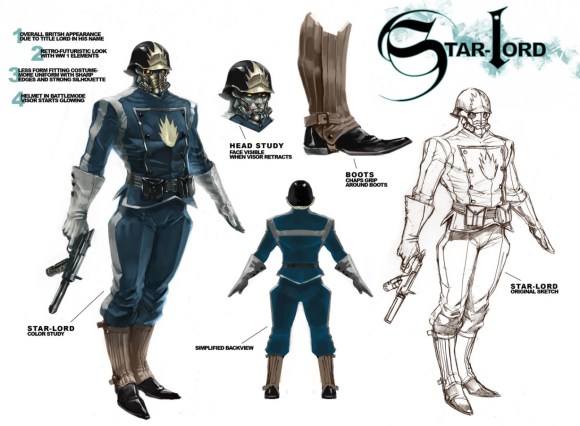
Wishing to inspire the other team member with his legacy as a cosmic guardian chosen by higher powers, Peter’s uniform was personalized to include elements of his Star-Lord uniform. This look was designed by Marko Djurdjevic, who was influenced by the “Lord” part of “Star-Lord” to give the outfit a sense of a British military uniform. This is a very utilitarian outfit, with a face mask that offers protection and universal translation. The only superhero/science-fiction touches, aside from the strange mask, are the star designs on the helmet and chest. This outfit most closely resembles the original Star-Lord uniform when viewed from the back. It’s good and it fitted the character at the time. The silhouette is also very strong compared to before. I’m just not wild about the white and light blue color combination. It’s not striking enough to me and the fact is Quill’s first costume was meant to be black and white with touches of gold.
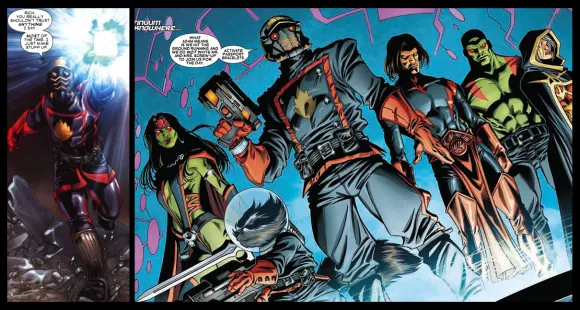
Annihilation: Conquest led to a new Guardians of the Galaxy series that started in 2008. Originally, that name had been used by a group of heroes who lived in the 30th century. Now it applied to a new strike force that Peter Quill organized in the modern day, a team that would proactively hunt evil and ensure, as best they could, that wide-scale conflict such as the Annihilation War and the Phalanx War were stopped before they got out of hand. They also became protectors of space and time itself, since reality had become weakened due to the scale of the recent interstellar wars.
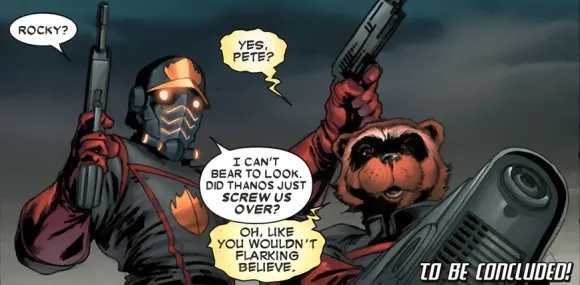
In this team, Peter, Groot and Rocket Raccoon kept their Dirty Dozen uniforms but changed the colors. The other team members got their own matching outfits, each personalized slightly just as Peter’s was. This here is a great uniform. The red and black just makes the entire outfit stronger. Sometimes, the black was replaced with a dark shade of navy blue. The helmet-mask also looks cooler with glowing yellow lights than mild glowing red lights. A great improvement overall.
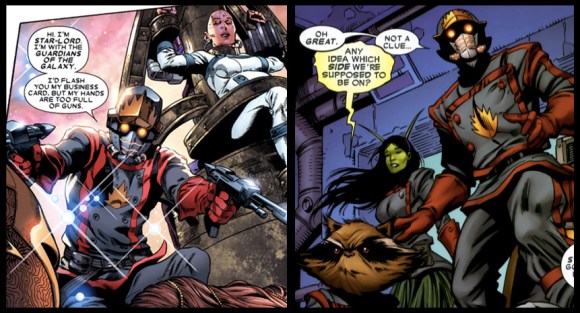
This Guardians of the Galaxy series was written by Dan Abnett and Andy Lanning, with art provided by Paul Pelletier and Rick Magyar for the first several issues. I highly recommend it. The book quickly became a fan-favorite and pushed characters such as Star-Lord, Rocket Raccoon, Groot, Gamora and others into higher levels of popularity. It was a great combination of high-concept science fiction and fantasy coupled with fun banter from characters who realized how absurd their lives were.
Sadly, the series ended after just two years. The last issue was #25, released in 2010. The series ending led into a story called the Thanos Imperative, which involved Peter Quill and his teammate Drax apparently sacrificing their lives to stop a great evil from unleashing across the universe. The remaining Guardians went their separate ways.
THE RETURN
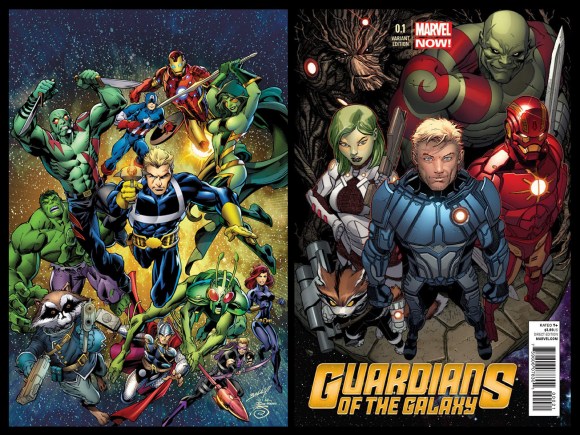
Peter Quill was dead. The Guardians of the Galaxy had disbanded. But in 2012, the new series Avengers Assemble began, in part to capitalize on the team’s popular live-action movie that was released that same year. In the opening story arc, written by Brian Michael Bendis and with art by Mark Bagley, the Guardians showed up as an operational team again and had Peter Quill as the leader. He was alive and well, wearing his original Star-Lord outfit, and suddenly blond again for the first time since the 1970s.
This led to the new Guardians of the Galaxy series in 2013 that is still currently ongoing, written by Brian Michael Bendis. Exactly how Peter Quill survived his apparent death hasn’t been revealed yet, but teasing hints have implied that Star-Lord went through a dark journey and may have sacrificed a lot to return to life. Along with this mystery, Bendis retconned Peter Quill’s origin, modernizing the Chris Claremont elements while eliminating just about everything Steve Englehart had written and proposed.
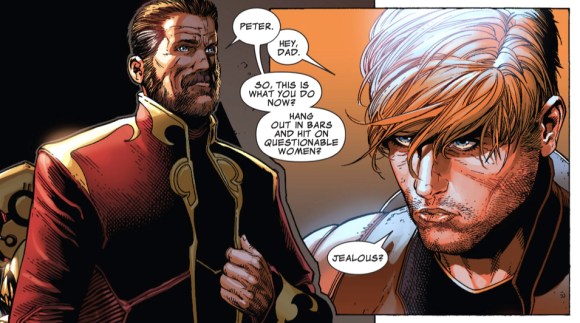
In Guardians of the Galaxy # 0.1 – with art by Steve McNiven, John Dell, and Justin Ponsor – we were given a new story that showed Peter’s father was not Emperor Jason but rather King J’Son. He still crashed on Earth and stayed to repair his ship, still belonged to the Spartax Empire, still fell in love with Meredith Quill. But this time, he didn’t mind-wipe her when he left her behind to return to his war. Meredith never married and decided to raise Peter on her own from the beginning.
When Peter was eleven, she was targeted and killed by members of the Badoon, a race of reptilian aliens who were enemies of the 30th century Guardians of the Galaxy. The Badoon tried to kill Peter too and he just barely escaped with his life, destroying his would-be killers in the process. Whether he became an astronaut or not hasn’t been revealed. In the subsequent issue, Guardians of the Galaxy vol. 3 #1, we saw that Peter Quill, now about 30 years old, had later learned about his true heritage and came to resent his father King J’Son for abandoning him and his mother.
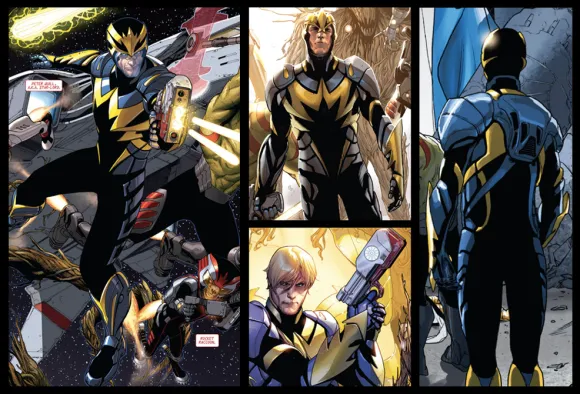
Following his apparent death and the Guardians of the Galaxy going separate ways, Peter lived in the Spartax Empire, openly questioning the political policies and rulings of his father. Events then led to him reforming the Guardians and adopting a new suit of armor. Starting with issue #2 of the series, Sarah Pichelli joined the book’s art team. She took over from McNiven in issue #4 but headed out with issue 7, and the art team has changed a couple times since then.
I think all of these are good changes that streamline and modernize Peter Quill in a good way. I also think the new armor is a great modernization of the original Star-Lord look and it’s nice to have a helmet that at lasts shows Peter’s face. The suit gets a little complicated in the back, but otherwise it’s a solid design.
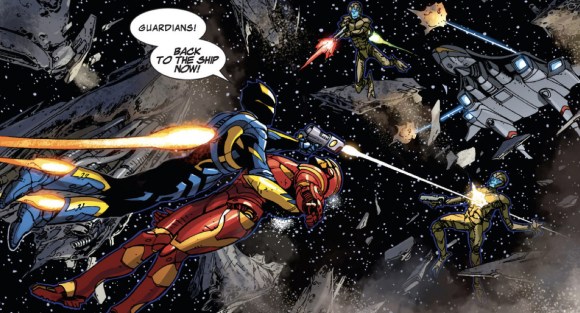
Now here’s something else that’s different. In the new origin story, there’s no mention of the Master of the Sun or the sentient Ship. “Star-Lord” seems to just be a title used for the prince of the Spartax Empire. Peter was never, as far as we know, chosen to be a cosmic guardian by a god-like being. This definitely puts a couple of his adventures into question (and I mean recent ones, obviously we have to now ignore the original stories). It also means that everything Englehart, Star-Lord’s creator, wrote is now gone, with the exception of the character’s name and the element gun.
Speaking of the element gun (which I guess now wasn’t destroyed, despite what was seen in Annihilation and Annihilation: Conquest), the new origin story says it is no longer a cosmic gift given to each Star-Lord but rather a specialized and highly dangerous weapon custom made for J’Son, who left it behind with Meredith, leaving it for Peter to inherit. It has the same abilities as the previous version of the weapon, except it now also shoots lightning.
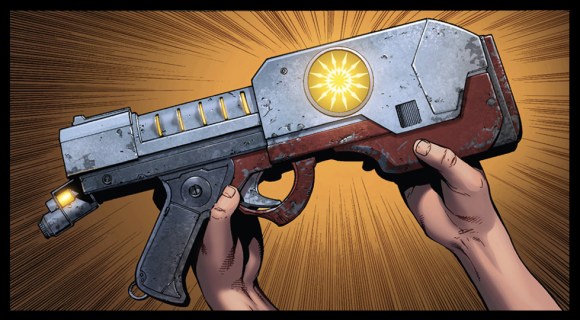
I think that origin works for the gun and I like that it looks more impressive now, with a sunburst design on the side that evidently is the royal seal of Spartax, which is why a similar image appears on the Star-Lord armor. That’s a nice connection and I appreciate that the gun remains a one-of-a-kind piece of technology. I just miss the idea that Peter was chosen to represent a cosmic legacy that made him a legend among different races.
Despite my feeling on this, the new Guardians of the Galaxy series is excellent and Bendis has been doing an excellent job keeping the book pretty friendly for new readers who aren’t savvy with too much of the Marvel Universe or the long, complicated pasts of some of Peter’s teammates. You should go check it out and pick up the trades of Annihilation: Conquest and Abnett and Lanning’s Guardians of the Galaxy run.
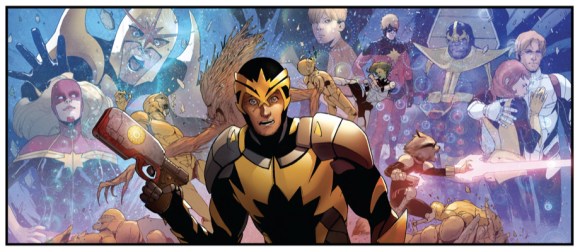
I hope you enjoyed this look at the man called Star-Lord. I’m very excited to see how he’s brought to life on the big screen this summer. Remember, you can send us suggestions of what characters you would like to see explored in this column in the future. Until next time, This is Alan Kistler, signing off.
Alan Sizzler Kistler (@SizzlerKistler) is an actor and writer who identifies as a feminist and time traveler in training. He was once chosen to be the Star-Lord but then realized he would rather be a Time Lord because they have larger wardrobes and roomier space ships. He is the author of Doctor Who: A History.



